Ready to push your model rocket’s performance to the limit? In "Maximizing Thrust: Tips for Efficient Model Rocket Engine Performance," we explore practical strategies and advanced techniques that can help you squeeze every bit of power from your engine. Whether you're a beginner eager to learn the basics or a seasoned rocketeer chasing record altitudes, these insights will help you achieve optimal thrust and efficiency for every launch.
Quick Links to Useful Sections
- Understanding the Fundamentals of Thrust
- Tuning Your Engine for Optimal Thrust
- 1. Optimize Fuel Grain Geometry
- 2. Fine-Tune the Nozzle Design
- 3. Maintain Consistent Fuel Quality
- 4. Minimize Internal Friction and Heat Loss
- Engine Installation and Integration Tips
- Advanced Techniques for Thrust Maximization
- Digital Simulation and CFD Analysis
- Custom Propellant Formulations
- Active Nozzle Adjustments
- Maintenance Tips for Consistent Performance
- Model Rocket Engine Performance FAQs
- Your Next Launch: Ignite Your Engine and Soar Higher
Understanding the Fundamentals of Thrust
Thrust is the force that propels your rocket upward, generated by the rapid expulsion of exhaust gases. At the heart of engine performance are key factors such as burn rate, nozzle design, and fuel efficiency. By understanding these fundamentals, you can make informed adjustments that significantly improve your rocket’s performance.
- Burn Rate: How quickly your propellant combusts affects the intensity and duration of thrust.
- Nozzle Efficiency: The nozzle’s shape and size determine how effectively the energy from the burning fuel is converted into directed thrust.
- Fuel Quality: The chemical composition and purity of your fuel influence both the energy output and consistency of the burn.
With these core concepts in mind, you can start optimizing each component for maximum performance.
Tuning Your Engine for Optimal Thrust
Small tweaks can yield significant improvements in thrust. Here are some actionable tips for tuning your engine:
1. Optimize Fuel Grain Geometry
The shape of your solid fuel grain can impact the burn surface area and, consequently, the burn rate. Experiment with different grain geometries to find the balance that delivers the right mix of rapid energy release and sustained thrust.
Looking For The Best Model Rocket Kits? You'll Love These:
2. Fine-Tune the Nozzle Design
A well-designed nozzle is critical for converting combustion energy into thrust. Ensure your nozzle is smooth and properly contoured to minimize energy losses. Consider experimenting with different expansion ratios to see how they affect your engine’s efficiency.
3. Maintain Consistent Fuel Quality
Using high-quality, consistent fuel formulations helps ensure predictable engine performance. Always store fuel under proper conditions and check for signs of degradation before each launch.
4. Minimize Internal Friction and Heat Loss
Ensure that the engine’s internal surfaces are smooth and free from debris. Reduced friction means more energy is directed towards producing thrust rather than being lost as heat.
Engine Installation and Integration Tips
How your engine is integrated into your rocket can also affect overall thrust. Consider these installation tips:
- Secure Mounting: Make sure the engine is firmly seated and aligned within the rocket body. Any misalignment can lead to energy losses and reduced thrust efficiency.
- Proper Insulation: Use appropriate insulating materials to protect engine components from premature heat loss, thereby maximizing the thermal energy available for propulsion.
- Streamlined Engine Compartment: Ensure that the area around the engine is as aerodynamic as possible to reduce drag that can counteract the engine’s thrust.
A well-integrated engine setup not only boosts thrust but also contributes to overall flight stability and efficiency.
Advanced Techniques for Thrust Maximization
For those looking to push beyond basic adjustments, advanced techniques can further refine engine performance:
Digital Simulation and CFD Analysis
Use Computational Fluid Dynamics (CFD) software to simulate engine behavior under various conditions. Digital tools can help you model airflow, heat distribution, and exhaust dynamics, enabling you to make data-driven adjustments to both the fuel grain and nozzle design.
Custom Propellant Formulations
Experiment with different propellant mixtures to enhance energy output and burn consistency. Many advanced rocketeers work with tailored formulations that offer a higher impulse or longer burn time, depending on their flight objectives.
Active Nozzle Adjustments
Some experimental setups allow for variable geometry nozzles, which adjust during flight to optimize thrust under different conditions. Although this technology is still emerging in the hobby, it represents an exciting frontier for maximum engine efficiency.
These advanced strategies require a higher degree of technical expertise and access to specialized tools, but they can lead to dramatic improvements in thrust and overall engine performance.
Maintenance Tips for Consistent Performance
Regular maintenance is key to ensuring that your engine consistently delivers optimal thrust:
- Inspect Engine Components: After each launch, check for signs of wear or damage. Replace any components that show degradation.
- Clean Internal Surfaces: Remove any soot or residue buildup that could impair combustion efficiency.
- Monitor Fuel Storage: Keep fuel in optimal conditions to preserve its performance characteristics.
By maintaining your engine and related components, you ensure reliable, high-thrust performance over repeated launches.
Model Rocket Engine Performance FAQs
Here are some frequently asked questions to help you troubleshoot and optimize your engine’s thrust performance.
1. What is the most critical factor for maximizing thrust?
Achieving a smooth, efficient combustion process, through optimal fuel grain design and nozzle configuration, is key to maximizing thrust.
2. How does nozzle design impact engine efficiency?
A well-designed nozzle efficiently converts the thermal energy of combustion into directed thrust, reducing energy losses and improving overall performance.
3. Can I adjust the burn rate of my rocket engine?
With solid rocket engines, the burn rate is fixed by the fuel formulation and grain geometry, while hybrid and liquid engines offer more controllability.
4. What role does fuel quality play in engine performance?
High-quality, consistent fuel ensures predictable burn characteristics and maximum energy output, which are crucial for sustained thrust.
5. How can digital simulation help improve thrust?
Simulation tools allow you to model airflow and combustion dynamics, enabling precise adjustments to fuel and nozzle designs that can significantly enhance thrust.
6. What maintenance practices help maintain optimal engine performance?
Regular cleaning, component inspections, and proper fuel storage are essential for preserving engine efficiency and maximizing thrust over time.
7. Are there any safety risks when trying to maximize thrust?
Pushing engine performance always comes with increased risk, so it’s crucial to follow manufacturer guidelines and perform rigorous testing to ensure safety.
8. Can modifications to the engine compartment affect thrust?
Yes, ensuring a streamlined engine compartment minimizes drag and maximizes the energy available for propulsion, directly impacting thrust.
9. What advanced techniques are available for experienced rocketeers?
Techniques such as custom propellant formulations, CFD analysis, and active nozzle adjustments allow for significant performance enhancements.
10. How do I know if my engine is performing at its peak?
Monitoring key metrics such as thrust, burn time, and impulse, through test launches and simulation data, helps you determine if your engine is optimized for maximum performance.
Your Next Launch: Ignite Your Engine and Soar Higher
Maximizing thrust isn’t just about raw power, it’s about achieving the perfect balance between fuel efficiency, engine design, and safety. With these tips and techniques, you’re equipped to push your model rocket’s engine to its full potential.
Embrace the science, conduct thorough tests, and never stop refining your design. Every launch is a new opportunity to optimize and innovate. So fuel up, fine-tune your engine, and get ready to watch your rocket soar to unprecedented heights!
Looking For The Best Model Rocket Kits? You'll Love These:
Useful Interruption: Dive deeper into the world of Model Rockets with our most popular sections. If there is anything you think is missing or anything you would love for us to write about, just give us a shout.
- Getting Started & Basics With Model Rockets
- Model Rocket Design, Build & Customization
- Model Rocket Propulsion & Engine Technology
- Model Rocket Launch Techniques & Recovery
- Model Rocket Advanced Rocketry & Innovations
- Model Rocket DIY and Customization
- Model Rocket Equipment Reviews & Digital Tools
- Community, Competitions & Education
- Model Rocket Troubleshooting & FAQs
- Model Rocket Bonus/Seasonal & Niche Topics
A group of model rocket enthusiasts gathered at a field for their weekly launch event. Among them was Dave, a seasoned builder known for pushing the limits of hobby rocketry. This time, he had outdone himself.
“Ladies and gentlemen,” Dave announced, dramatically pulling a cloth off his latest creation, “I present to you: The Kraken!”
The crowd gasped. This wasn’t just a model rocket, it was a monster. The thing stood 8 feet tall, had six clustered engines, and was covered in enough duct tape to qualify as a classified aerospace project.
“Dave,” muttered Steve, the cautious safety officer, “Have you, uh… done the math on this?”
“Math?” Dave scoffed. “I built it in my garage at 3 a.m. with parts from eBay. This is an art piece, Steve.”
The countdown began.
5…
4…
3…
2…
1…
The engines ignited with a BOOM, and The Kraken shot up… kind of. It immediately did a violent barrel roll, narrowly missing the spectators before skyrocketing at an angle that could only be described as “legally questionable.”
The crowd collectively ducked as The Kraken flew straight over the adjacent cornfield, where Old Man Jenkins, the grumpiest farmer in town, was minding his business.
KABOOM!
The rocket disappeared behind the barn. A moment later, a flaming piece of Estes igniter wire landed at Steve’s feet. The silence was deafening.
And then, an unmistakable sound echoed across the field.
Jenkins’ shotgun being cocked.
“DAVE!!!” Steve shouted. “RUN.”
And that was the day Dave invented the first-ever biologically powered rocket booster: pure adrenaline.
To this day, nobody knows where The Kraken landed, but legend has it, it still haunts the skies, terrifying unsuspecting drones and low-flying birds.






